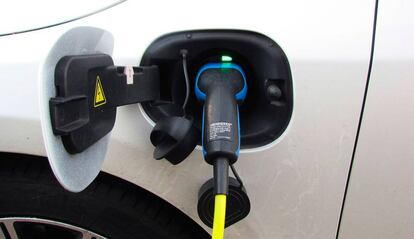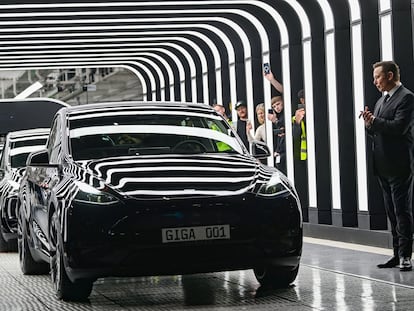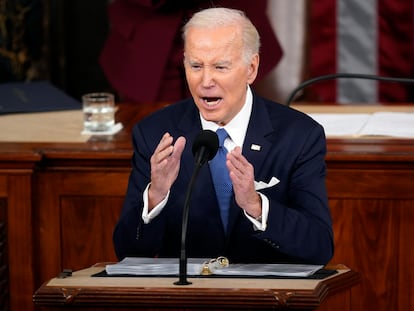EV sales will drive drop in global fuel consumption at the end of this decade
Studies point to 2030 at the latest for a decline in demand for gasoline and diesel as electric vehicles continue to make inroads. Almost one in three new cars in China and one in four in Europe are already plug-in hybrids

The progressive advance of electric vehicles (EVs) on a global scale will begin to make a dent in the global consumption of gasoline and diesel before the end of this decade. According to a recent study by Bank of America, the global peak in demand for automobile fuel will take place between 2028 and 2030, forecasts that are in line with the latest projections from BloombergNEF and the International Energy Agency (IEA). The other source of reduction in fuel consumption, though in a lesser degree, has to do with the replacement of older cars with newer, more fuel-efficient ones.
In 2023, global demand for gasoline — the fuel of choice for light vehicles on a global scale — will grow by 450,000 barrels per day, an increase that the Bank of America feels cannot be sustained for a very long time. Its research found that global adoption of electric vehicles reached 14% last year, and estimated that this rate will accelerate in the medium term, causing a peak in the demand for gasoline in 2030. In a conversation with EL PAÍS, the global head of raw materials and derivatives at this institution, Francisco Blanch, added that this peak will likely take place sometime “between 2028 and 2030.″
Despite existing resistance, transportation is approaching a revolution that will also shake the foundations of energy as we know it today. “Transportation is decoupling from oil relatively quickly, and what we are seeing in cars today we will soon see in buses,” Blanch points out. “We are facing a huge shift, a total paradigm shift: European car dealers are accumulating delays of between eight and 12 months waiting for EVs, and what this means is that there is a lot of demand from drivers.” The value of internal combustion engine cars “is already starting to plummet.” And that, he says, is just the beginning: “In the consumer’s mind, something has begun to change,” he notes.
EVs are making especially fast inroads in China (where they already represent 27% of all new vehicles for sale) and in Europe (23%), but little by little they are gaining traction throughout the globe: if the Bank of America’s forecast holds true, the current global penetration of 14% will skyrocket to 38% by the end of the decade. And it will also lead to a radical change in energy supply chains, with a gradual decline in fossil fuels in favor of electricity: their numbers suggest that the peak demand for fuels will occur when 20% of new cars sold in all the world are electric.
The report notes, however, that the path does not necessarily have to be linear, and that the speed of the transition will depend on the availability of scarce materials needed for car batteries, such as lithium, cobalt and copper.
More than 10 million new EVs this year
Sales of internal combustion engine cars, both gasoline and diesel, reached a peak in 2017, according to figures cited by BloombergNEF. That year, a total of 86 million units were sold, compared to just one million pure electric or plug-in hybrids. Since then, sales of internal combustion engines have dropped to 69 million, while EV sales rose to more than 10 million.
In 2021, the world’s still meager fleet of battery-powered cars consumed about 50 terawatt hours (TWh) of electricity, less than 0.5% of global consumption, according to the IEA. Although the demand for crude continued to grow, it did so by 0.3 million barrels per day less than it would have done in its absence. In 2030, if the scenario of zero net emissions is fulfilled in the middle of this decade, this displacement of oil usage should be around 7 million barrels per day, a very considerable figure in light of the fact that current global consumption is around 100 million barrels.
The shift has only just begun, especially in advanced economies, where greater purchasing power allows citizens to more easily embrace the added cost of a battery-powered vehicle. But the BloombergNEF figures suggest that in Southeast Asia, one of the fastest growing regions in the world, a large share of new vehicle registrations will also be for electric cars.
The fact that fuel consumption will continue to grow in the coming years is due, above all, to the enormous number of internal combustion engine vehicles sold in recent decades that will remain on the roads until their owners choose to replace them. The global fleet of gasoline and diesel cars, however, should begin to fall at the end of the decade, bringing down demand for both fuels.
Sign up for our weekly newsletter to get more English-language news coverage from EL PAÍS USA Edition
Tu suscripción se está usando en otro dispositivo
¿Quieres añadir otro usuario a tu suscripción?
Si continúas leyendo en este dispositivo, no se podrá leer en el otro.
FlechaTu suscripción se está usando en otro dispositivo y solo puedes acceder a EL PAÍS desde un dispositivo a la vez.
Si quieres compartir tu cuenta, cambia tu suscripción a la modalidad Premium, así podrás añadir otro usuario. Cada uno accederá con su propia cuenta de email, lo que os permitirá personalizar vuestra experiencia en EL PAÍS.
¿Tienes una suscripción de empresa? Accede aquí para contratar más cuentas.
En el caso de no saber quién está usando tu cuenta, te recomendamos cambiar tu contraseña aquí.
Si decides continuar compartiendo tu cuenta, este mensaje se mostrará en tu dispositivo y en el de la otra persona que está usando tu cuenta de forma indefinida, afectando a tu experiencia de lectura. Puedes consultar aquí los términos y condiciones de la suscripción digital.
More information
Archived In
Últimas noticias
Welcome to the post-religion era: The idea of Christianity as the absolute truth has become obsolete
‘I thought you would like it’: The risky sexual practice popularized by TV shows and TikTok
The digitalization of tourism: ‘They promise experiences and gave us the worst possible one’
Mexican peso defies uncertainty with forecasts of a new period of stability in 2026
Most viewed
- Sinaloa Cartel war is taking its toll on Los Chapitos
- Reinhard Genzel, Nobel laureate in physics: ‘One-minute videos will never give you the truth’
- Oona Chaplin: ‘I told James Cameron that I was living in a treehouse and starting a permaculture project with a friend’
- Why the price of coffee has skyrocketed: from Brazilian plantations to specialty coffee houses
- Silver prices are going crazy: This is what’s fueling the rally











































